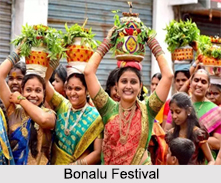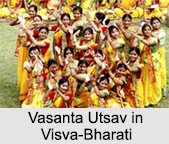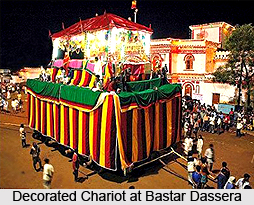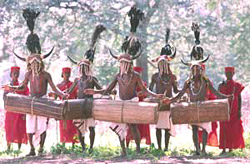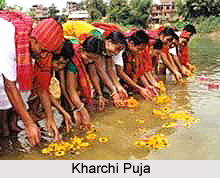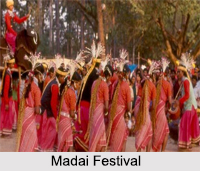Bhagavatipaattu is known as one of the most popular forms of art in Kerala. This basically comprise songs that are sung in praise of the goddess Bhagavati. The Brahmins and some other castes perform Nallammapaattu and Mutippurapaattu in adoration of the goddess.
Bhagavatipaattu is generally performed in the temples or by the Brahmins at their homes because this is considered as a ritual for appeasing the goddess Bhagavati. This ritual postulates drawing the posture of the goddess in different vibrant colours. The people of Kerala believe in a legend that is popularized in the locality. As per the legend, in the ancient time, a young girl was married long after her puberty. Due to this reason her children were excluded by the upper castes. Then they formed a new community that is called by the name of Pushpaka community. The job of the people of this community was to arrange flowers, making garlands for goddess Kali and organizing dance festivals and songs in the Kaavus. Sometimes they were also involved in organizing such kind of festivals in the homes of Kshatriya and Brahmin community.
Bhagavatipaattu is presented in a different manner. In case of the festival of the Brahmins, a canopy of red and white cloth is made and it is decorated with areca palms and banana leaves. Rice paste is used to draw the shape of the temple on the ground. During the worship, the Brahmin wives sing songs and the Brahmins chant to appease Lord Ganesha and goddess Saraswati. Their songs get much intensity by the accompaniment of Elattaalam, cymbals, horns and pipes, a bronze plate. Later, a Pushpaka woman comes decked with beautiful clothes and shawl. She enters in front of the huge crowd with a plate of rice in her hand. Initially the woman sways gently with the music and gradually her dance becomes fast and frantic due to the possession of the goddess in her body. After having occupied her body and soul, the goddess starts her revelations by the mouth of the Pushpaka woman. Later a Kurup priest accompanies her with a shield and sword in his hand.
There is a series of rituals of Bhagavattipattu that takes place before and after Bhagavatipaattu. It starts with the morning and ends with the annihilation of the Demon Darika at noon. It accompanies with the hymns sung to appease the goddess Kali. During this chanting and singing of the hymns, two women appear with pound rice and turmeric in a mortar that is covered with cloth. Moreover, the juice of banyan and mango leaves, trees, coconut-palm and a liquid that is of blood colour. As the music grows fast, the pounder is beaten with more fervour. At last, the mortar is circumambulated and tumbled eastward. The water that comes out of the pot is considered as the blessings of the goddess Bhagavati.
Apart from this, another ritual is also organised by the Velas in South Kerala. They arrange this ritual for the lower caste people. In this ritual, picture painting is done and the painted picture is destroyed by a dance. It is said that the dance should be performed by a woman who has refrained from sexual intercourse. Sacrifices of fowls and goats are common practice during this ritual. After the sacrifice, the priest starts his frenzied dance and finally breaks the branches of the trees that were used in the ceremony. With this the ritual comes to an end.
Moreover, as this ritual is to appease the Goddess Kali, there are many forms of rituals distinguishing only in content, dance, song, theme and make-up and for this reason these rituals get different names. Apart from Brahmins, Bhagavatipaattu is also presented by other castes namely Black smiths, Maaraar, Malayar etc.
